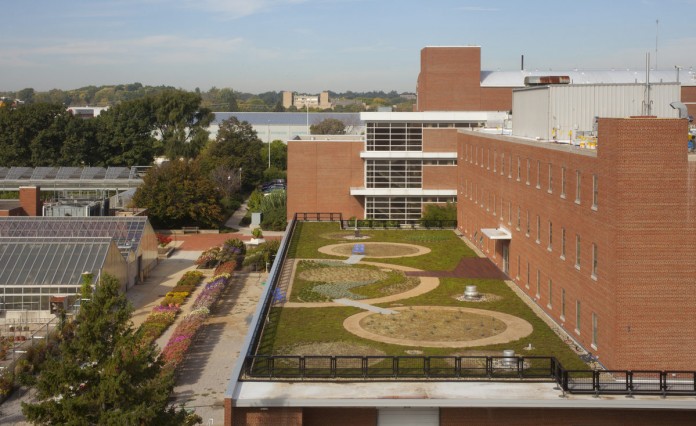COLUMBUS — Ohio State University’s first publicly accessible green roof is open to visitors at Howlett Hall on the campus of the College of Food, Agricultural, and Environmental Sciences.
The green roof, or rooftop garden, is part of the university’s Chadwick Arboretum and Learning Gardens.
The 12,000-square-foot green roof was installed in August and September on the back of Howlett Hall, 2001 Fyffe Court, over the building’s extended ground floor.
Original plan
Previously, the roof was accessible through a first-floor conference room, which had been built with a doorway to allow people to step out onto the roof.
The roof had been meant to house a rooftop garden since the building was dedicated in 1967, said Mary Maloney, director of Chadwick.
“Many people dreamed of getting this done, but Megan Welsh carried the ball over the goal line,” Maloney said.
Project champion
Welsh, a certified green roof professional and the project’s coordinator, had attended Ohio State after high school but left before graduating for a decade-long career in film editing in Los Angeles.
She returned to the university in 2009 after becoming inspired by the promise of green roofs. Welsh decided to double-major in construction management and horticulture, and soon met Maloney, who immediately began talking with her about helping Chadwick move forward with Howlett’s green roof plans.
Welsh began working on the project as a student and stayed on as a consultant after graduating in December 2011 and opening her own firm, Higher Ground Green Roofs, LLC. During that time, the university began making plans for the old roof, which was “leaking, blighted, and needed to be replaced,” Welsh said.
“We jumped on board with Ohio State’s schedule to place the green roof on top of the new roof as soon as it was installed.”
Quick work
On Aug. 12, Howlett Hall had a conventional tar and chip roof, but by Sept. 6 it had a fully planted garden.
Once the new conventional roof was completed in August, work began on the green roof.
First, the new roof’s membrane was covered with a heavy-duty protection fabric, with a lightweight drainage layer installed over top of that.
“We kept the existing drains, so any rainwater the plants don’t use will be drained away,” Welsh said.
Then, about 4-6 inches of lightweight growing medium, engineered specifically for green roofs, was added, mounded in some areas to add interest to the rooftop landscape, along with curved walking paths.
The plants were planted in September and included: blue fescue, Geum tangerine, coreopsis, achillea (yarrow), black-eyed Susan, Talinum calycinum, prairie dropseed, lavender, Allium cernuum, Sempervivum black (Hens & Chicks), thyme (four varieties) and sedum (18 varieties).
“We may need to make adjustments in the future,” Welsh said. “Some plants may do better than others. But that’s OK, this is a process.”
Funding
Chadwick Arboretum raised more than $400,000 for the green roof project, Maloney said. The green roof itself cost about $200,000, Welsh said, plus $100,000 for the new guardrail and another $100,000 in pre-construction design and engineering.
Others in Columbus
The Columbus area has several other green roofs, including one at the Grange Insurance Audubon Center, Grange Insurance Corporate Headquarters, The Lazarus Building, the Columbus Commons underground parking garage, Franklin County Courthouse and the Dublin Community Recreation Center, but none are easily accessible to the casual visitor, Welsh said.
“We really want this to be a demonstration of green technology — a repeatable example so more people realize they can do this,” she said. “It doesn’t have to cost $2 million to build a green roof. It can be attainable.”
See for yourself
A new entryway to the roof from the first floor of Howlett Hall is currently being completed, Maloney said, but the garden is open to visitors except during times when work on the entry’s construction periodically blocks access.










